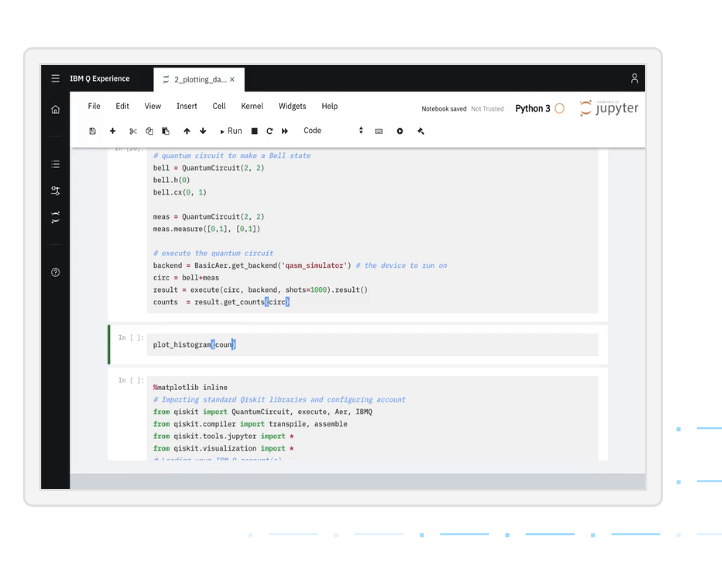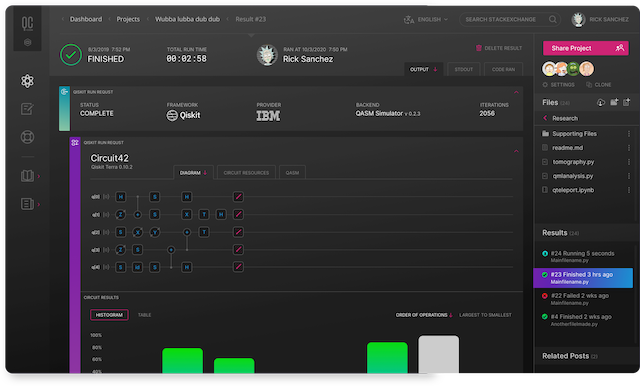শুরুর নির্দেশনা#
স্থাপন (ইনস্টলেশন)#
Let's get started using Qiskit! The first thing to do is choose how you're going to run and install the packages. There are three main ways to do this:
Qiskit supports Python 3.7 or later. However, both Python and Qiskit are evolving ecosystems, and sometimes when new releases occur in one or the other, there can be problems with compatibility.
You will need to download Python on your local system to get started. Jupyter is recommended for interacting with Qiskit.
We recommend using Python virtual environments to cleanly separate Qiskit from other applications and improve your experience.
Create a minimal environment with only Python installed in it.
python3 -m venv /path/to/virtual/environment
Activate your new environment.
source /path/to/virtual/environment/bin/activate
Note: if you are using Windows, use the following commands in PowerShell.
python3 -m venv c:\path\to\virtual\environment
c:\path\to\virtual\environment\Scripts\Activate.ps1
Next, install the Qiskit package.
pip install qiskit
If the packages were installed correctly, you can run pip list to see the active
packages in your virtual environment.
If you intend to use visualization functionality or Jupyter notebooks it is
recommended to install Qiskit with the extra visualization support:
pip install qiskit[visualization]
It is worth pointing out that if you're a zsh user (which is the default shell on newer
versions of macOS), you'll need to put qiskit[visualization] in quotes:
pip install 'qiskit[visualization]'
The following cloud vendors have Qiskit pre-installed in their environments:
IBM Quantum Lab
Build quantum applications and experiments with Qiskit in a cloud programming environment.

Strangeworks
A platform that enables users and organizations to easily apply quantum computing to their most pressing problems and research.

Installing Qiskit from source allows you to access the current development version, instead of using the version in the Python Package Index (PyPI) repository. This will give you the ability to inspect and extend the latest version of the Qiskit code more efficiently.
Begin by making a new virtual environment and activating it:
python3 -m venv QiskitDevenv
source QiskitDevenv/bin/activate
Installing from source requires that you have the Rust compiler on your system. To install the Rust compiler the recommended path is to use rustup, which is a cross-platform Rust installer. To use rustup you can go to:
which will provide instructions for how to install rust on your platform. Besides rustup there are other installation methods available too.
Once the Rust compiler is installed, you are ready to install Qiskit.
Clone the Qiskit repository.
git clone https://github.com/Qiskit/qiskit-terra.git
Cloning the repository creates a local folder called
qiskit-terra.cd qiskit-terra
If you want to run tests or linting checks, install the developer requirements.
pip install -r requirements-dev.txt
Install
qiskit-terra.pip install .
If you want to install it in editable mode, meaning that code changes to the project don't require a reinstall to be applied, you can do this with:
pip install -e .
Installing in editable mode will build the compiled extensions in debug mode without optimizations. This will affect the runtime performance of the compiled code. If you'd like to use editable mode and build the compiled code in release with optimizations enabled you can run:
python setup.py build_rust --release --inplace
after you run pip and that will rebuild the binary in release mode.
If you are working on Rust code in Qiskit you will need to rebuild the extension
code every time you make a local change. pip install -e . will only build
the Rust extension when it's called, so any local changes you make to the Rust
code after running pip will not be reflected in the installed package unless
you rebuild the extension. You can leverage the above build_rust command to
do this (with or without --release based on whether you want to build in
debug mode or release mode).
You can then run the code examples after installing Qiskit. You can run the example with the following command.
python examples/python/using_qiskit_terra_level_0.py
Platform Support#
Qiskit strives to support as many platforms as possible, but due to limitations in available testing resources and platform availability, not all platforms can be supported. Platform support for Qiskit is broken into 3 tiers with different levels of support for each tier. For platforms outside these, Qiskit is probably still installable, but it's not tested and you will have to build Qiskit (and likely Qiskit's dependencies) from source.
Additionally, Qiskit only supports CPython. Running with other Python interpreters isn't currently supported.
Tier 1#
Tier 1 supported platforms are fully tested upstream as part of the development processes to ensure any proposed change will function correctly. Pre-compiled binaries are built, tested, and published to PyPI as part of the release process. These platforms are expected to be installable with just a functioning Python environment as all dependencies are available on these platforms.
Tier 1 platforms are currently:
Linux x86_64 (distributions compatible with the manylinux 2014 packaging specification).
macOS x86_64 (10.9 or newer)
Windows 64 bit
Tier 2#
Tier 2 platforms are not tested upstream as part of development process. However, pre-compiled binaries are built, tested, and published to PyPI as part of the release process and these packages can be expected to be installed with just a functioning Python environment.
Tier 2 platforms are currently:
Linux i686 (distributions compatible with the manylinux 2014 packaging specification) for Python < 3.10
Windows 32 bit for Python < 3.10
Linux aarch64 (distributions compatible with the manylinux 2014 packaging specification)
Tier 3#
Tier 3 platforms are not tested upstream as part of the development process. Pre-compiled binaries are built and published to PyPI as part of the release process, with no testing at all. They may not be installable with just a functioning Python environment and may require a C/C++ compiler or additional programs to build dependencies from source as part of the installation process. Support for these platforms are best effort only.
Tier 3 platforms are currently:
Linux ppc64le (distributions compatible with the manylinux 2014 packaging specification)
Linux s390x (distributions compatible with the manylinux 2014 packaging specification)
macOS arm64 (10.15 or newer)
Linux i686 (distributions compatible with the manylinux 2014 packaging specification) for Python >= 3.10
Windows 32 bit for Python >= 3.10
আরো এগোতে প্রস্তুত?...#
Qiskit from the ground up
Learn how to build, execute, and post-process quantum circuits with Qiskit.
Start learning QiskitDive into the tutorials
Find out how to leverage Qiskit for everything from single-circuits to full quantum application development.
Qiskit tutorials